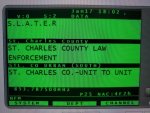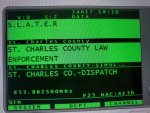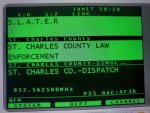rbritton1201
Captain1201
- Joined
- Jul 27, 2020
- Messages
- 407
I've been monitoring St. Charles County, via S.L.A.T.E.R, I think/maybe, and they do not appear to be "E'cryptonited " I'm receiving signals for all the municipalities in St. Charles County. I'm a little confused because I don't notice any control channel signal indicators, and I was expecting to see evidence of control channel activity. I'm receiving signals loud and clear from all the municipalities, as well as St. Charles County Police. I have talk groups programmed into the system under what is categorized as S.L.A.T.E.R. within Sentinel. I don't understand why I would be receiving excellent signals via S.L.A.T.E.R, via talk groups programmed via Sentinel right from the data base, but I see no control channel indicator. I can't figure out whether I'm just receiving "conventional" signals, which it appears I am, or transmissions via S.L.A.T.E.R. I can't figure out if these agencies in St. Charles County are only enrolled in S.L.A.T.E.R as a backup, or what. I was expecting not to be able to monitor St. Charles County Public Safety at all because I figured that if they were a part of S.L.A.T.E.R, they would all be automatically "E'cryptonited." There is a list of "E'Cryptonited" agencies in RR, and the only agencies that appear in the list in St. Charles County are their OPS channels, which is understandable if conducting undercover work, etc...But, their main dispatch channels and car to car traffic seems to be open.
Conversely, I have Jefferson County programmed into the scanner under S.L.A.T.E.R via Sentinel, and I can see where there is control channel activity. I know they are "E'cryptonited," but I can receive signals from Pevely PD just fine, which I believe is programmed under S.L.A.T.E.R as well. Not surprisingly, I don't hear any traffic out of Jeffco, which was to be expected., and I don't seem to hear any other municipalities in Jefferson County, which was also to be expected. But, Pevely was kind of a pleasant surprise, not that I'm ever down that way, but with this "E'cryptonite" craze, it's a bit of a surprise.
St. Louis County? Hughhh! forget it! But, no surprise...
Can anyone explain why I'm not seeing control channel activity in St. Charles County, but monitoring them flawlessly? I assume I'm able to receive Pevely PD because they have their cloaking device turned off. I assume that perhaps that's the case with St. Charles County agencies as well, but why no control channel signal activity?
Conversely, I have Jefferson County programmed into the scanner under S.L.A.T.E.R via Sentinel, and I can see where there is control channel activity. I know they are "E'cryptonited," but I can receive signals from Pevely PD just fine, which I believe is programmed under S.L.A.T.E.R as well. Not surprisingly, I don't hear any traffic out of Jeffco, which was to be expected., and I don't seem to hear any other municipalities in Jefferson County, which was also to be expected. But, Pevely was kind of a pleasant surprise, not that I'm ever down that way, but with this "E'cryptonite" craze, it's a bit of a surprise.
St. Louis County? Hughhh! forget it! But, no surprise...
Can anyone explain why I'm not seeing control channel activity in St. Charles County, but monitoring them flawlessly? I assume I'm able to receive Pevely PD because they have their cloaking device turned off. I assume that perhaps that's the case with St. Charles County agencies as well, but why no control channel signal activity?





